#Buick Century Convertible
Explore tagged Tumblr posts
Text

1958 Buick Century Convertible

1958 Buick Century Convertible

1958 Buick Century Convertible
A gorgeous luxury 1958 Buick Century Convertible
In 1958, Buick's production dipped, and the GM marque slipped to fifth place in the industry having been replaced by another GM brand, Oldsmobile. Nonetheless, the 1958 designs have become some of the most eye-catching Buicks in its history. In fact, Buick's General Manager Edward Ragsdale described the 1958 Buicks as “dazzling” and for fans of chrome, stainless, and overall fifties excess, the word “dazzling” is most fitting.
In 1958, Buick offered five distinct series, starting with the entry-level Special and culminating with the top-of-the-line Limited series. The intermediate level '58 Buicks, consisted of the Century, Super, and Roadmaster series. While the Super only was offered in two body styles, both the Century and Roadmaster featured a greater variety of body styles including convertible models. The Century sported numerous factory standard options including Dynaflow Automatic transmissions, full wheelcovers, padded dashes, and clocks, among other items. Sitting atop the Century hierarchy was the convertible models that were also equipped with power windows and power front seats. In total, only 2,558 Century Convertibles were produced in 1958, which makes this particular example quite a rare piece of automotive history. Under the hood is a 364 Cubic Inch Nailhead V8 engine fed by an upgraded single 4 barrel Edelbrock carburetor. The 364 Nailhead V8 is backed by a Dynaflow Automatic Transmission that makes this classic Buick a breeze for just about anybody to drive. Exhaust exits through this '58 Buick's through-bumper exhaust setup that generates a nice throaty sound out of the rear.
109 notes
·
View notes
Text

Buick Century convertible
13 notes
·
View notes
Text

Buick Century Convertible 1956. - source Amazing Classic Cars.
140 notes
·
View notes
Text



1939 Buick Century Convertible Phaeton
My tumblr-blogs:
www.tumblr.com/germancarssince1946 & www.tumblr.com/frenchcarssince1946 & www.tumblr.com/englishcarssince1946 & www.tumblr.com/italiancarssince1946 & www.tumblr.com/japanesecarssince1947 & www.tumblr.com/uscarssince1935
189 notes
·
View notes
Text

Buick Century Convertible (66C)
1936 USA
39 notes
·
View notes
Text
1938 Buick Century Convertible... Love the "Rumble Seat"!

56 notes
·
View notes
Text
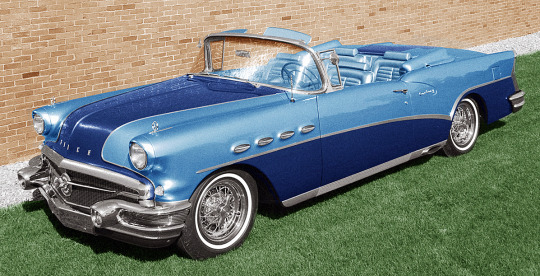

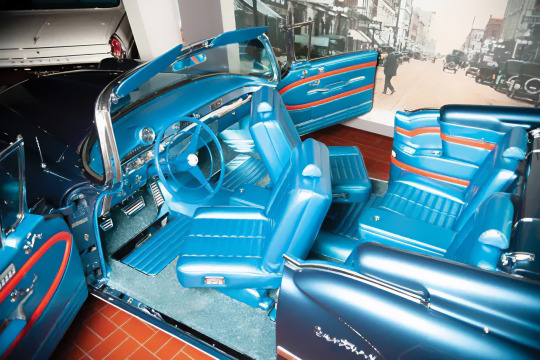
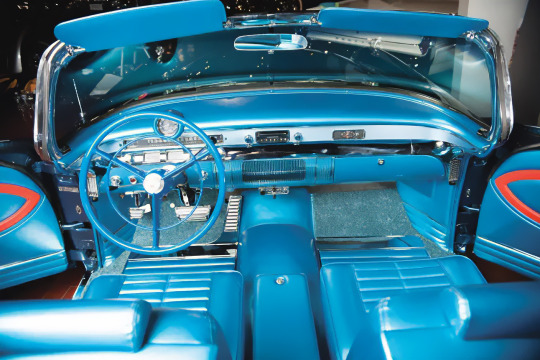
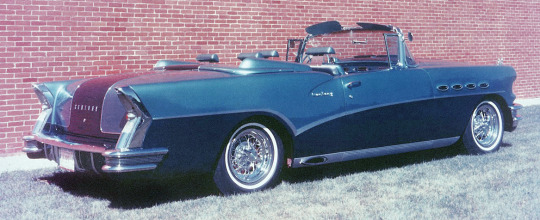
Buick Century X, 1956. A one-off that was built for Bill Mitchell, GM director of styling. The car included 225 unique features including power swivelling seats
#Buick#Buick Century X#1956#one-off#Buick Century#1956X#Bill Mitchell#prototype#swivelling seats#convertible#open roof
218 notes
·
View notes
Photo

Un Buick Century Convertible de 1958, con menos de 31,000 millas, esta tasado en $195,000 USD, unos $4,250,000 pesos mexicanos, además de tener su V8, viene configurado con una transmisión Dynaflow, además de tener la suspensión “air-poise” sustituyendo a la de resortes, además, de todas las opciones adicionales para el auto. Siendo un auto no restaurado, incrementa su valor, y con 2,588 autos fabricados durante ese año, lo hacen un auto difícil de encontrar, y más en esas condiciones. Se encuentra disponible en la Auto Collection en Las Vegas, por si gustas ir por el! #car #auto #másqueclásicosyogui #classic #classiccars #classiccar #autohistory #carhistory #buick #century #dynaflow #sale #convertible #airpoise #lasvegas @buickusa @buickmexico https://www.instagram.com/p/CBRpru3MW0t/?igshid=1fv880o022g1l
#car#auto#másqueclásicosyogui#classic#classiccars#classiccar#autohistory#carhistory#buick#century#dynaflow#sale#convertible#airpoise#lasvegas
0 notes
Text




1954 Buick Century Convertible & Riviera Hardtop
These two models are 1:43 scale and crafted in white metal. The Century Riviera Hardtop was released by Motor City USA-Design Studio Series. It is in Condor Yellow & Carlsbad Black. The Century Convertible was released by Motor City USA-American Models Series. It is in Matador Red.
3 notes
·
View notes
Text

1938 Buick Century convertible, one of only 642 produced
2 notes
·
View notes
Text



Buick Century Convertible 4-Door 1940. - source Classic Old Cars.
49 notes
·
View notes
Text


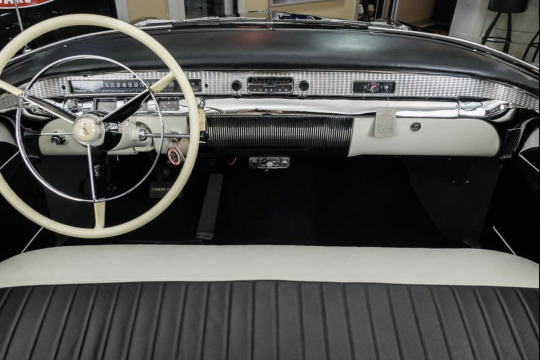
1956 Buick Century Convertible
My tumblr blogs:
www.tumblr.com/germancarssince1946 & www.tumblr.com/frenchcarssince1946 & www.tumblr.com/englishcarssince1946 & www.tumblr.com/italiancarssince1946 & www.tumblr.com/japanesecarssince1947 & www.tumblr.com/uscarssince1935 & www.tumblr.com/swedishcarssince1946
24 notes
·
View notes
Text
The evolution of the car has been a long one, but as time moves on, technology develops faster and faster. The first car was invented in 1886 if you believe Mercedes-Benz, and then Henry Ford revolutionized how they were built with the Model T in 1908. In 1922, electronic ignition replaced the starter crank handle, but it wasn’t until 1949 that Chrysler introduced the keyed ignition into production cars. Cigarette lighters came to automobiles in 1921, then car radios in 1930
Once entertainment was taken care of, power steering appeared as far back as 1951, and then Chrysler introduced air conditioning in 1953, and cruise control appeared as early as 1958. Three-point seat belt appeared in 1959 courtesy of Volvo, while the 1960s saw electric windows, heated seats, and intermittent wipers appear. Anti-lock brakes were first seen in 1971, in 1973, the catalytic converter turned up to ruin everyone’s fun for nearly twenty years, and the first digital dashboard appeared in 1974. Airbags started becoming standard in the 1980s, then, in the 1990s, things started picking up. That’s where we’ll start with the evolution of modern car technologies as we know them
1990: Built-In Satellite Navigation
We take a GPS based navigation for granted now, but once upon a time, people had to use paper maps and written directions. Then companies started playing with navigation systems in cars, which were problematic for several reasons, mainly in being able to pinpoint the car’s location accurately. Then, in 1990, Mazda was the first to put a GPS based navigation system in a production vehicle. It went into the Japanese market Eunos Cosmo, which is a whole article in itself. The first GPS navigation system in a US car came from Oldsmobile and was a $1,995 option in 1995. It wasn’t until 2000 that the US government made a more accurate GPS signal available for civilian use, and GPS based navigation started to become commonplace
1996: Connected Cars
The term ‘connected cars’ has become a buzzword in the 21st century, but it was GM working with Motorola that created the first connected system for a car, and they called it OnStar. The first OnStar telematics systems could call emergency services if an airbag deployed, and was first fitted to the Cadillac Eldorado, DeVille, and Seville. Over time, the ability to add GPS locations and the ability to transmit voice and data at the same time evolved. OnStar is still a feature on cars and in its tenth generation and with a lot more features added, but virtually every automaker has a similar system available
#gallery-0-62 { margin: auto; } #gallery-0-62 .gallery-item { float: left; margin-top: 10px; text-align: center; width: 33%; } #gallery-0-62 img { border: 2px solid #cfcfcf; } #gallery-0-62 .gallery-caption { margin-left: 0; } /* see gallery_shortcode() in wp-includes/media.php */
1998: Color Head-Up Display
The head-up display (HUD) was a futuristic sci-fi wonder in the 1980s. The first automotive head-up display appeared on the Oldsmobile Cutlass Supreme Indy Pace Cars and replicas in 1998. They became more widely available, and Toyota and Nissan started offering them on select models, most notably the Nissan 240SX. They’ve now become a common option for cars, and many automakers make them standard on higher trims. Most HUD systems use color to draw the eye to pertinent information, but the first car to offer a color head-up display was the 1998 Chevrolet Corvette. Cadillac then offered a HUD in the XLR, and BMW pushed development hard with the 2003 5 Series
#gallery-0-63 { margin: auto; } #gallery-0-63 .gallery-item { float: left; margin-top: 10px; text-align: center; width: 33%; } #gallery-0-63 img { border: 2px solid #cfcfcf; } #gallery-0-63 .gallery-caption { margin-left: 0; } /* see gallery_shortcode() in wp-includes/media.php */
1999: Laser Adaptive Cruise Control
Mercedes has a long list of technology it has brought to market before anyone else, often in its most premium of premium models. Mitsubishi pioneered laser-controlled cruise control with a lidar-based cruise control system that used throttle and transmission control to adapt the car’s speed but didn’t use the brakes. Mercedes introduced its Distronic system in 1999 on the S-Class and CL as the first radar-assisted Autonomous cruise control system available worldwide. Its impact reverberates still as autonomous vehicle technology slowly creeps forward
#gallery-0-64 { margin: auto; } #gallery-0-64 .gallery-item { float: left; margin-top: 10px; text-align: center; width: 33%; } #gallery-0-64 img { border: 2px solid #cfcfcf; } #gallery-0-64 .gallery-caption { margin-left: 0; } /* see gallery_shortcode() in wp-includes/media.php */
2000/2001: Bluetooth
A Bluetooth connection to our cellphones is something we take for granted in 2020, and it’s rare for a car to be sold without Bluetooth technology as standard. In the mid-1990s, you could buy a car stereo head unit with Bluetooth, but it was a while before it appeared as an option. History is a little hazy about which manufacturer offered it from the factory first as Chrysler saw it as a great idea early on, but it’s likely the Acura TL was the first car to be offered in the US with the technology equipped
#gallery-0-65 { margin: auto; } #gallery-0-65 .gallery-item { float: left; margin-top: 10px; text-align: center; width: 33%; } #gallery-0-65 img { border: 2px solid #cfcfcf; } #gallery-0-65 .gallery-caption { margin-left: 0; } /* see gallery_shortcode() in wp-includes/media.php */
2001: Modern Infotainment System
It’s hard to pin down when the infotainment system, as we know it today, came into being. BMW introduced its iDrive system to the 7 Series in 2001; it featured a prominent screen that was controlled by a central knob and meant fewer buttons on the dashboard. But the first touchscreen in a car dates back to the 1986 Buick Riviera and its green-and-black cathode-ray tube display. At that time, Popular Mechanics wrote that the touchscreen “violates the First Commandment of ergonomics – you must take your eyes off the road to make any adjustments.” 21 years later, after the release of the first Apple iPhone in 2007, we saw the big move to touchscreen systems in cars
#gallery-0-66 { margin: auto; } #gallery-0-66 .gallery-item { float: left; margin-top: 10px; text-align: center; width: 33%; } #gallery-0-66 img { border: 2px solid #cfcfcf; } #gallery-0-66 .gallery-caption { margin-left: 0; } /* see gallery_shortcode() in wp-includes/media.php */
2002: Parking Camera
The first example of a rearview camera goes back to the 1956 Buick Centurion concept car. Volvo also toyed with the idea in 1972 Volvo Experimental Safety Car, but it didn’t make it into production for some time. The first production car with a rear camera was the Japanese market 1991 Toyota Soarer Limited, but not the US market’s Lexus SC equivalent. However, it was Infiniti that added guidelines for parking on the 2002 Q45 flagship sedan, which debuted at the New York Auto Show in 2000. Nissan also used the 2002 Nissan Primera to introduce the technology outside of the US and Japan. Legislation introduced in 2018 has subsequently made the humble reverse camera standard in all modern cars. The concept of a surround-view camera then arrived on the 2008 Infiniti EX35, using four cameras to give a bird’s eye view of the vehicle, with numerous manufacturers following suit
#gallery-0-67 { margin: auto; } #gallery-0-67 .gallery-item { float: left; margin-top: 10px; text-align: center; width: 33%; } #gallery-0-67 img { border: 2px solid #cfcfcf; } #gallery-0-67 .gallery-caption { margin-left: 0; } /* see gallery_shortcode() in wp-includes/media.php */
2004: Remote Start
Remote start technology had been available via the aftermarket for years before 2004, but that was the year GM decided to make the technology available direct from the factory. Before starting, the vehicles were set to run diagnostics in engine oil pressure, engine temperature, throttle position, brake/transmission shift position, and battery voltage. If everything checked out and the hood wasn’t open, the car could be started from the key fob and then be unlocked at the driver’s leisure. It has become an incredibly valuable feature for people living in climates with particularly hot or cold weather, allowing them to start the car and let it cool down or warm up before even leaving the house
#gallery-0-68 { margin: auto; } #gallery-0-68 .gallery-item { float: left; margin-top: 10px; text-align: center; width: 33%; } #gallery-0-68 img { border: 2px solid #cfcfcf; } #gallery-0-68 .gallery-caption { margin-left: 0; } /* see gallery_shortcode() in wp-includes/media.php */
2006: Self Parking Car
Lexus showed the world the first self-parking production car; the 2006 LS 460 sedan was unveiled at the Detroit International Auto Show, and the technology blew people away. To activate it, the driver had to put the car in reverse, which enabled the rearview camera, then press the parallel park icon on the touchscreen to place an indicator square over the parking space they wanted to use. The driver could then release the steering wheel while the car parked and maneuvered itself. Other manufacturers followed, and, with each iteration, the technology has gotten smoother, more precise, and faster to park
#gallery-0-69 { margin: auto; } #gallery-0-69 .gallery-item { float: left; margin-top: 10px; text-align: center; width: 33%; } #gallery-0-69 img { border: 2px solid #cfcfcf; } #gallery-0-69 .gallery-caption { margin-left: 0; } /* see gallery_shortcode() in wp-includes/media.php */
2007: Blind Spot Monitoring
As thicker pillars became prevalent due to safety legislation due to rollover risks, blind spots when using side-view mirrors became more problematic on passenger vehicles. Volvo developed its Blind Spot Information System and included it on its 2007 S80 sedan, which created a visible alert for the driver when changing lanes with another car present. Ford was Volvo’s parent company at the time and started using the same system for all of its brands. Mazda then used a similar system for its 2008 Mazda CX-9, but only in Grand Touring trim. In 2013, Mazda started making it more available through its range, and other companies followed suit. Blind-spot monitoring systems are now also used for rear-cross-traffic safety systems
#gallery-0-70 { margin: auto; } #gallery-0-70 .gallery-item { float: left; margin-top: 10px; text-align: center; width: 33%; } #gallery-0-70 img { border: 2px solid #cfcfcf; } #gallery-0-70 .gallery-caption { margin-left: 0; } /* see gallery_shortcode() in wp-includes/media.php */
2007: LED Headlights
The common halogen lamp is an energy-hungry unit and is usually only rated for around 800 hours of use, while High Intensity Discharge (HID) lighting is an expensive and complicated system that’s not the most ideal either. LED headlights, however, strike an excellent balance, and give bright white light, light up faster than halogen, are energy-efficient, and have a long operating life. They’re also easy to package as they use small bulbs and allow automakers to get creative with lighting designs.
The use of LEDs for exterior on cars goes back as far as the 1986 Chevrolet Corvette’s brake lights. Kia started using LED turn indicators in 2002, and then the 2007 Audi R8 used LED daytime running lights. Outside of the US, the R8 had the first option for LED headlights while, at the same time, the Lexus LS featured LED low beams and side markers in the US. The Cadillac Escalade featured low and high beams powered by LEDs in 2009, but it wasn’t until the current-generation Mercedes S-Class that we saw the first car to use exclusively LED lighting, both inside and out
#gallery-0-71 { margin: auto; } #gallery-0-71 .gallery-item { float: left; margin-top: 10px; text-align: center; width: 33%; } #gallery-0-71 img { border: 2px solid #cfcfcf; } #gallery-0-71 .gallery-caption { margin-left: 0; } /* see gallery_shortcode() in wp-includes/media.php */
2009: Smart Phone Connected Cars
Now, pretty much every automaker has something to offer in the way of smartphones interacting with a car. In 2009, Mercedes launched the first iteration of its ‘mbrace’ app to allow remote access to owner’s vehicles from their smartphone. It worked with iPhone and Blackberry and allowed remote door locking and unlocking as well as vehicle location. Since then, apps from automakers have increased in scope to include everything including diagnostics, checking the fuel level, the vehicle’s location, remote start, and even booking service appointments
#gallery-0-72 { margin: auto; } #gallery-0-72 .gallery-item { float: left; margin-top: 10px; text-align: center; width: 33%; } #gallery-0-72 img { border: 2px solid #cfcfcf; } #gallery-0-72 .gallery-caption { margin-left: 0; } /* see gallery_shortcode() in wp-includes/media.php */
2012: First License For Autonomous Cars
The race to build the first production autonomous car started in the 2010s. It was Google that secured the first license to take its experimental driverless technology on the road. The Toyota Prius was issued its license in Nevada and opened the gates to testing autonomous systems. That has led us to a plethora of driver assistance features on production cars, such as lane-keeping, collision avoidance, and advanced adaptive cruise control systems. In 2014, Tesla then dropped its first iteration of Autopilot for existing owners as the first commercially available system that can steer the car without input from the driver and change lanes on the motorway
#gallery-0-73 { margin: auto; } #gallery-0-73 .gallery-item { float: left; margin-top: 10px; text-align: center; width: 33%; } #gallery-0-73 img { border: 2px solid #cfcfcf; } #gallery-0-73 .gallery-caption { margin-left: 0; } /* see gallery_shortcode() in wp-includes/media.php */
2014: Apple CarPlay
A common problem with automaker’s infotainment systems has been that they are not designed well and are often operated on hardware to that found in the smartphone in the driver’s pocket. Apple’s CarPlay came to market in 2014, closely followed by Android Auto, to change that. Both Apple and Google lead the way with their voice control and navigation, and the systems use popular travel and music apps, integrating everyday life with the car, and ensuring that a car’s tech is never further behind than your easily-upgradable smartphone. All you currently have to do is plug in your phone, and it becomes the infotainment system
#gallery-0-74 { margin: auto; } #gallery-0-74 .gallery-item { float: left; margin-top: 10px; text-align: center; width: 33%; } #gallery-0-74 img { border: 2px solid #cfcfcf; } #gallery-0-74 .gallery-caption { margin-left: 0; } /* see gallery_shortcode() in wp-includes/media.php */
2018: Phone As Key
Keyless entry has been with us for a long time. Ford’s SecuriCode has been around since 1980, although it started out being called Keyless Entry System. It’s been a slow burn for the technology to become mainstream and has always required having your remote in your pocket. It seems incredible that it took so long, but Tesla introduced its customers to use a cellphone to replace the remote key fob in 2018. Model 3’s were able to sense the driver’s phone from up to 30 feet away and unlock the doors. There have been security and safety concerns, which is why the more traditional automakers have been slow to follow, but soon, this tech will be the go-to choice
#gallery-0-75 { margin: auto; } #gallery-0-75 .gallery-item { float: left; margin-top: 10px; text-align: center; width: 33%; } #gallery-0-75 img { border: 2px solid #cfcfcf; } #gallery-0-75 .gallery-caption { margin-left: 0; } /* see gallery_shortcode() in wp-includes/media.php */
Source carBuzz
The Evolution of Modern Car Technology The evolution of the car has been a long one, but as time moves on, technology develops faster and faster.
2 notes
·
View notes


